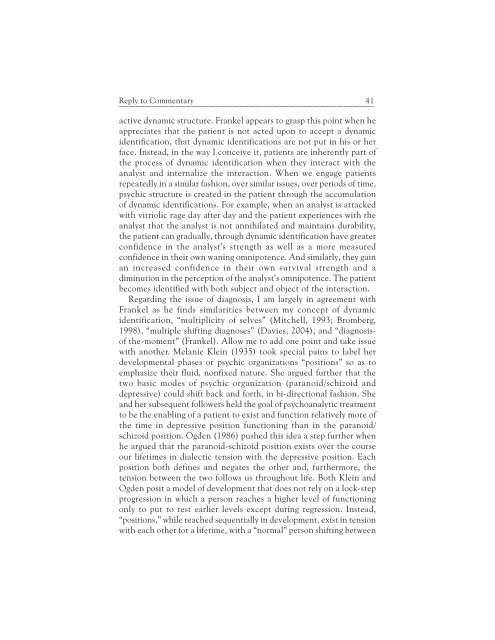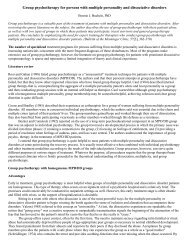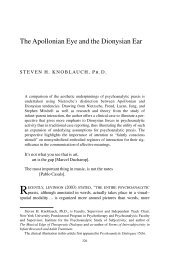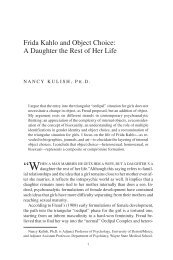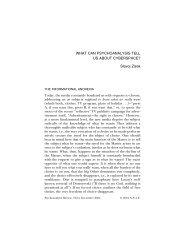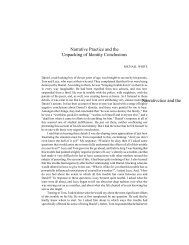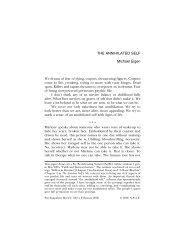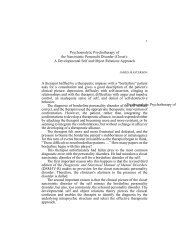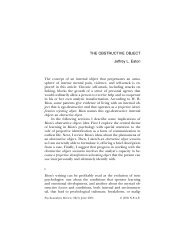What's a Good Object to Do? - PsyBC
What's a Good Object to Do? - PsyBC
What's a Good Object to Do? - PsyBC
Create successful ePaper yourself
Turn your PDF publications into a flip-book with our unique Google optimized e-Paper software.
Reply <strong>to</strong> Commentary 41<br />
⎯⎯⎯⎯⎯⎯⎯⎯⎯⎯⎯⎯⎯⎯⎯⎯⎯⎯⎯⎯⎯⎯⎯⎯⎯⎯⎯⎯⎯⎯⎯⎯⎯⎯⎯⎯⎯⎯⎯⎯⎯⎯⎯⎯<br />
active dynamic structure. Frankel appears <strong>to</strong> grasp this point when he<br />
appreciates that the patient is not acted upon <strong>to</strong> accept a dynamic<br />
identification, that dynamic identifications are not put in his or her<br />
face. Instead, in the way I conceive it, patients are inherently part of<br />
the process of dynamic identification when they interact with the<br />
analyst and internalize the interaction. When we engage patients<br />
repeatedly in a similar fashion, over similar issues, over periods of time,<br />
psychic structure is created in the patient through the accumulation<br />
of dynamic identifications. For example, when an analyst is attacked<br />
with vitriolic rage day after day and the patient experiences with the<br />
analyst that the analyst is not annihilated and maintains durability,<br />
the patient can gradually, through dynamic identification have greater<br />
confidence in the analyst’s strength as well as a more measured<br />
confidence in their own waning omnipotence. And similarly, they gain<br />
an increased confidence in their own survival strength and a<br />
diminution in the perception of the analyst’s omnipotence. The patient<br />
becomes identified with both subject and object of the interaction.<br />
Regarding the issue of diagnosis, I am largely in agreement with<br />
Frankel as he finds similarities between my concept of dynamic<br />
identification, “multiplicity of selves” (Mitchell, 1993; Bromberg,<br />
1998), “multiple shifting diagnoses” (Davies, 2004), and “diagnosisof<br />
the-moment” (Frankel). Allow me <strong>to</strong> add one point and take issue<br />
with another. Melanie Klein (1935) <strong>to</strong>ok special pains <strong>to</strong> label her<br />
developmental phases or psychic organizations “positions” so as <strong>to</strong><br />
emphasize their fluid, nonfixed nature. She argued further that the<br />
two basic modes of psychic organization (paranoid/schizoid and<br />
depressive) could shift back and forth, in bi-directional fashion. She<br />
and her subsequent followers held the goal of psychoanalytic treatment<br />
<strong>to</strong> be the enabling of a patient <strong>to</strong> exist and function relatively more of<br />
the time in depressive position functioning than in the paranoid/<br />
schizoid position. Ogden (1986) pushed this idea a step further when<br />
he argued that the paranoid-schizoid position exists over the course<br />
our lifetimes in dialectic tension with the depressive position. Each<br />
position both defines and negates the other and, furthermore, the<br />
tension between the two follows us throughout life. Both Klein and<br />
Ogden posit a model of development that does not rely on a lock-step<br />
progression in which a person reaches a higher level of functioning<br />
only <strong>to</strong> put <strong>to</strong> rest earlier levels except during regression. Instead,<br />
“positions,” while reached sequentially in development, exist in tension<br />
with each other for a lifetime, with a “normal” person shifting between


